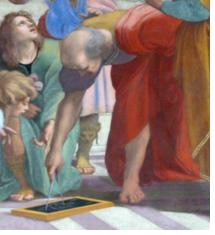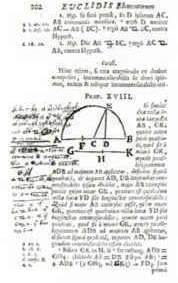 Euclid's birthdate and place of birth are unknown, but it is established that he founded a school in Alexandria during the reign of Ptolemy I Soter and taught mathematics, based on his own textbook, Elements.
Euclid's birthdate and place of birth are unknown, but it is established that he founded a school in Alexandria during the reign of Ptolemy I Soter and taught mathematics, based on his own textbook, Elements.mathematician and teacher; lived c. 300 BC (Alexandria, Egypt)
 Euclid's birthdate and place of birth are unknown, but it is established that he founded a school in Alexandria during the reign of Ptolemy I Soter and taught mathematics, based on his own textbook, Elements.
Euclid's birthdate and place of birth are unknown, but it is established that he founded a school in Alexandria during the reign of Ptolemy I Soter and taught mathematics, based on his own textbook, Elements.
Euclid's Elements are a compilation and reorganization of earlier texts, which quickly went out of fashion once Euclid's textbook became available. Hippocrates of Chios, who lived in the 5th century BC, was one of his sources. A textbook compiled by Theudius, which was in use at Plato's Academy of Athens and most likely also in Aristotle's Lyceum, also served a a source.
Other material came from works of Euclid's century, such as Theaetetus, who taught around 369 BC, and Eudoxus. Euclid restructured the content along his own design, redistributed theorems and propositions to suit his line of argument and invented new proofs based on material discussed up to that point in the text.
Euclid wrote other mathematical works, which are now lost. The Elements show him as an average mathematician - the parts not taken from other sources contain contrived argument and needless repetitions - but an absolutely outstanding teacher.
 Euclid obviously had an excellent reputation as a teacher already during his lifetime; the Greek philosopher Proclus reported in the 5th century AD that Ptolemy Soter asked him whether there was a shorter way to geometry than his Elements and received the reply: "There is no royal road to geometry."
Euclid obviously had an excellent reputation as a teacher already during his lifetime; the Greek philosopher Proclus reported in the 5th century AD that Ptolemy Soter asked him whether there was a shorter way to geometry than his Elements and received the reply: "There is no royal road to geometry."
The Elements remained the textbook for mathematics for more than 2000 years, until the development of non-Euclidean geometry in the 19th century. Commentaries appeared within a century. A revised and amended version was published in the 4th century AD by Theo of Alexandria and served as the basis for numerous translations and more than 1000 editions.
Newton (1643 - 1727) studied Euclid's Elements in great detail. The facsimile shows a page from his copy of the book, covered with his hand-written annotations.
Illustration: Euclid as teacher, detail from Raphael's ":School of Athens", Vatican; public domain.
Facsimile page: public domain.